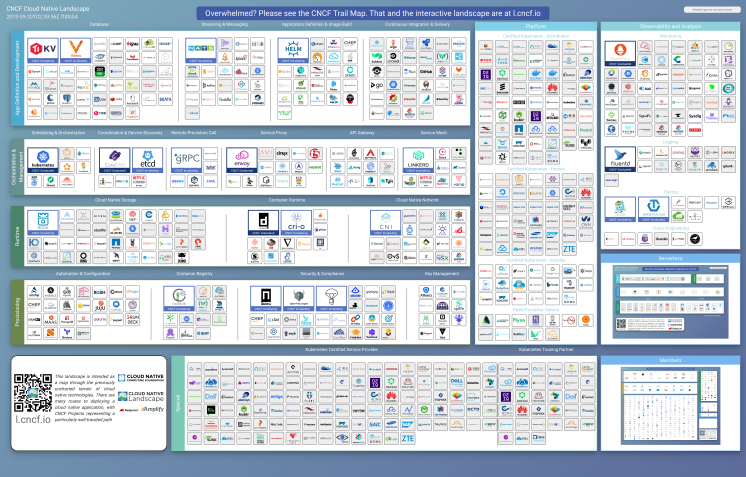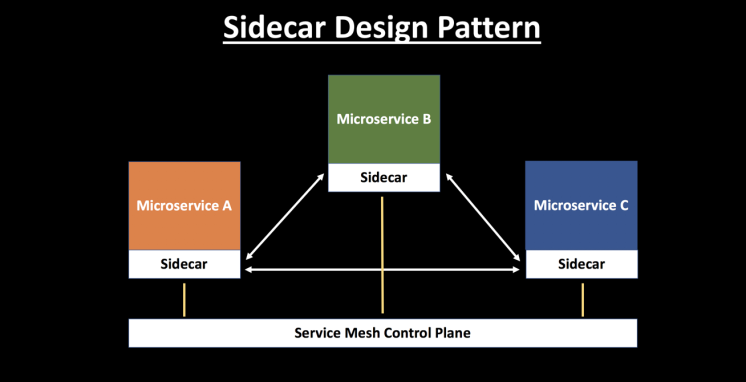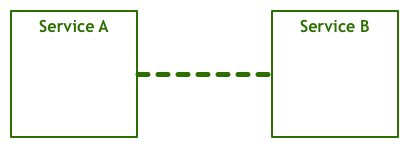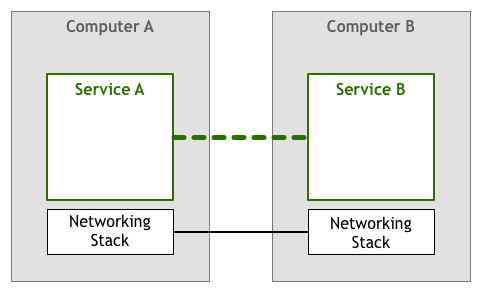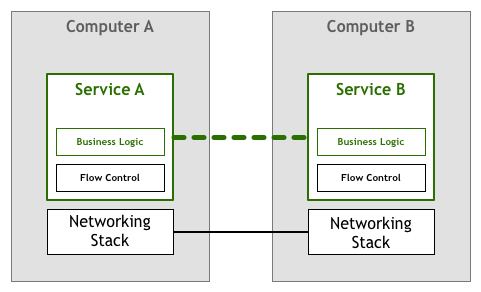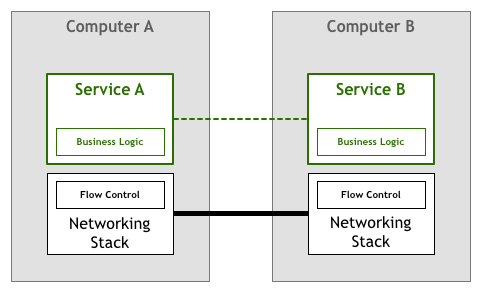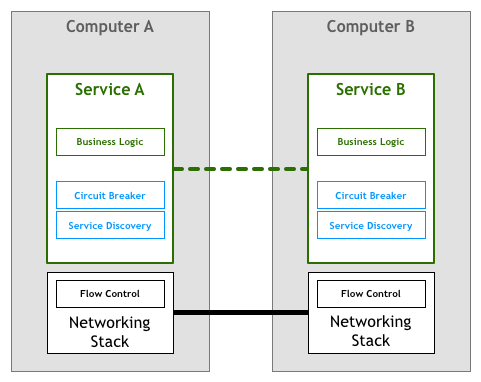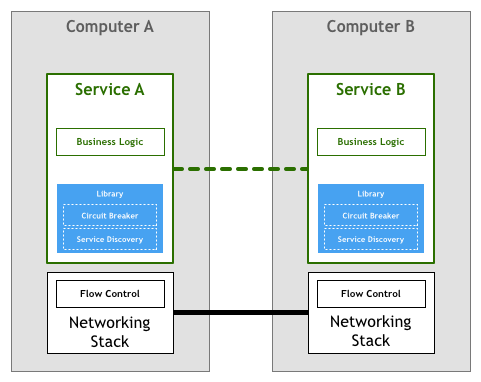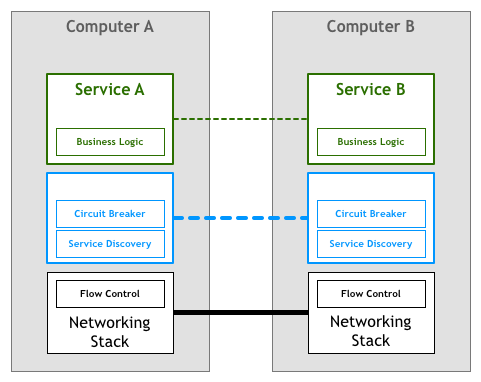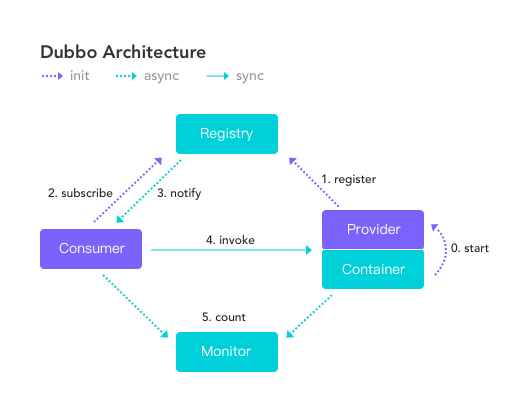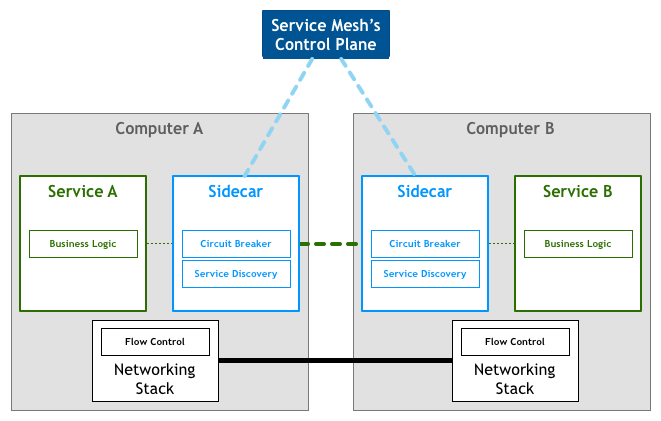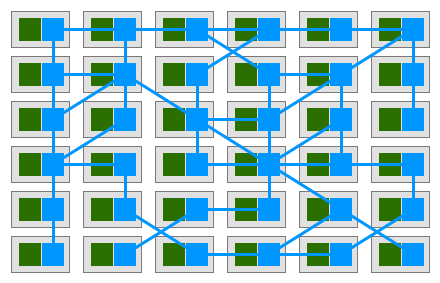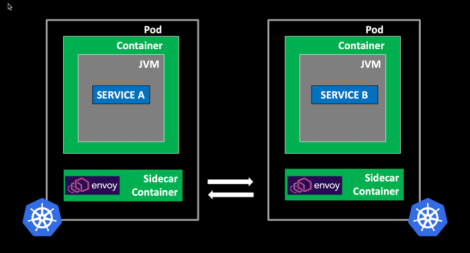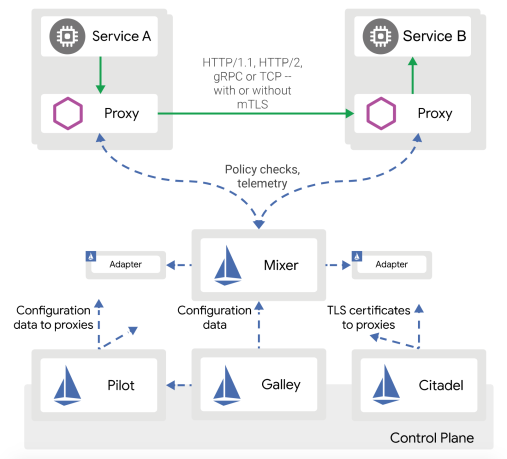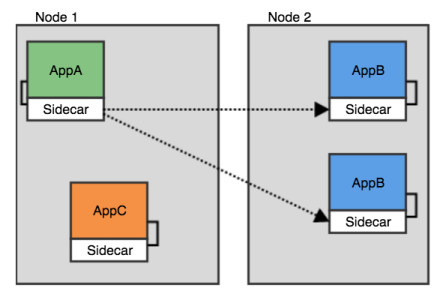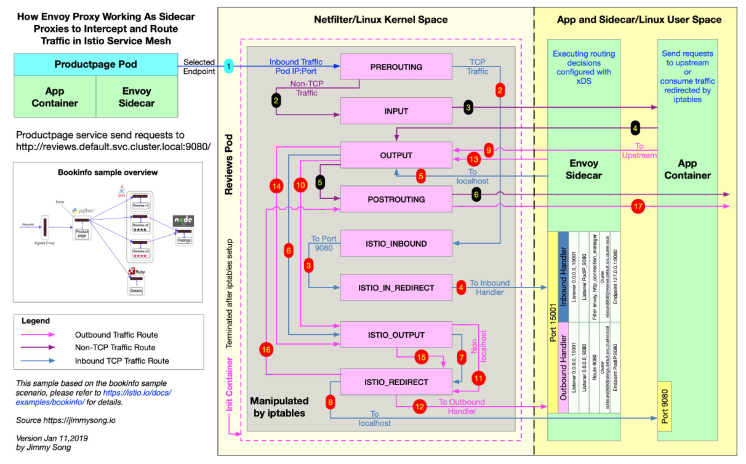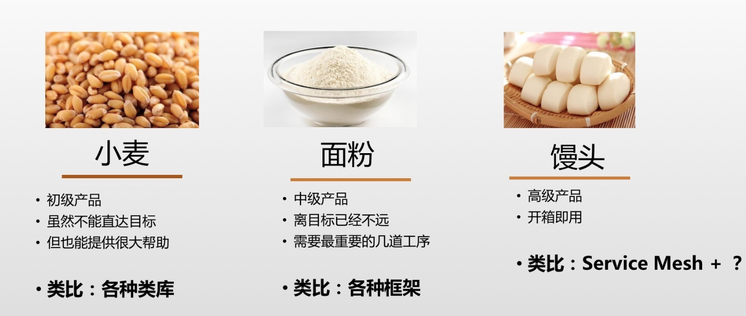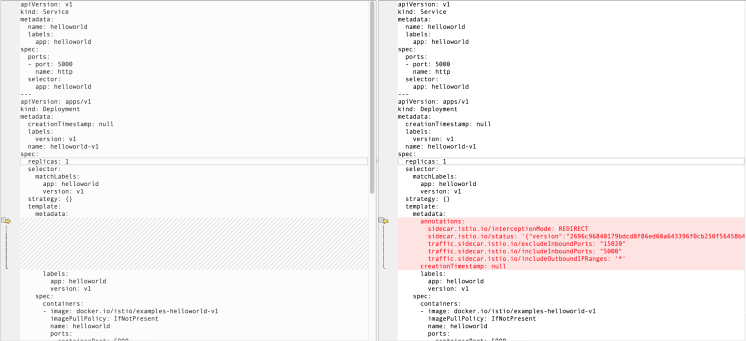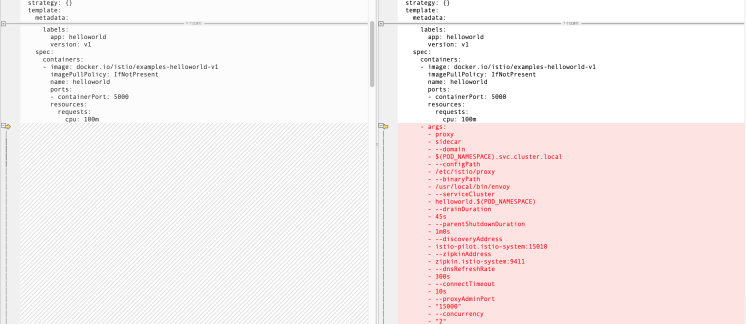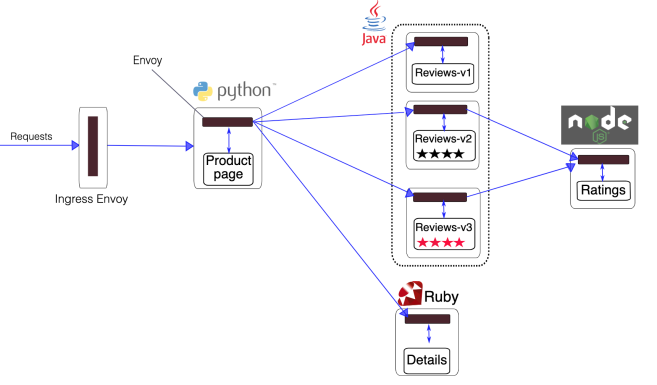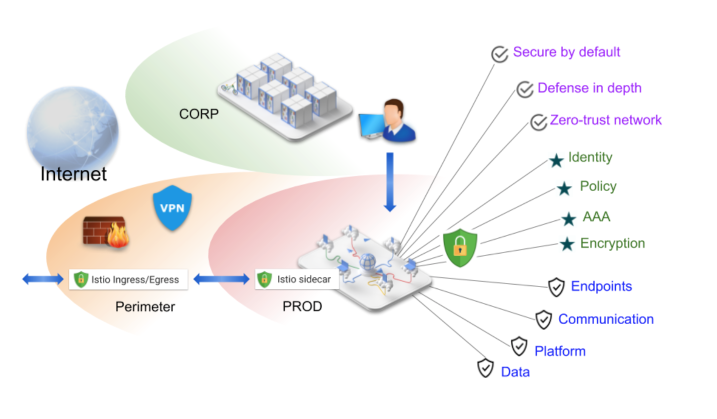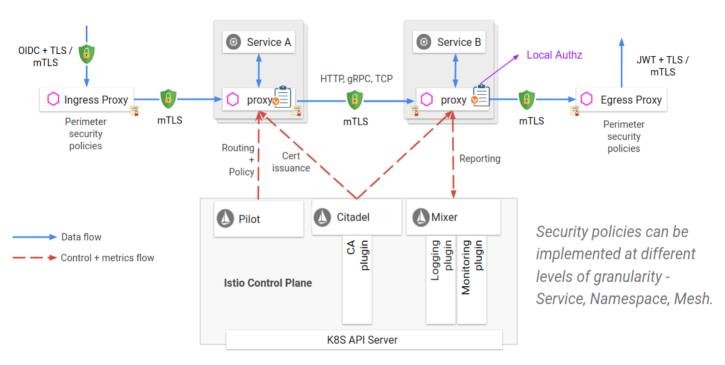Service Mesh · Istio · 以实践入门
前言
本文是笔者在学习官方文档、相关博客文章和实践过程中,整理了一些知识概念和自己的思考,主要在探索 lstio 的实际应用场景, Sidecar 原理, Service Mesh 为什么出现、要解决什么问题等,帮助我们思考微服务技术架构的升级和落地的可行性。
本文不是 Istio 的全部,但是希望入门仅此一篇就够。
概念
围绕云原生(CN)的概念,给人一种知识大爆炸的感觉,但假如你深入了解每一个概念的细节,你会发现它和你很近,甚至就是你手里每天做的事情。
图片来源:https://landscape.cncf.io/
关键词:Service Mesh、Istio、Sidecar、Envoy 等。
服务网格
服务网格( Service Mesh )是一个新瓶装旧酒的概念,它的发展随着微服务兴起,必然是早于 Kubernates 出现了。但 Kubernates 和 Istio 的出现,促使它成为了一种更火更标准化的概念。
Sidecar 是服务网格技术中常用的(其中)一种设计架构,在 Kubernates 中,不同的容器允许被运行在同一个 Pod 中(即多个进程运行在同一个 cgroup 下),这在很大程度上给 Sidecar 模式提供了良好的土壤。
首先看看 Sidecar 的设计:
图片来源于网络
为什么是新瓶旧酒?任何技术的发展都不是凭空地跳跃式发展的。
历史
原始的应用程序--图片来源于网络
独立的网络层--图片来源于网络
出现网络层(4层协议)控制的需求--图片来源于网络
控制逻辑下移到网络层--图片来源于网络
早期,应用程序随着功能迭代发展,尤其是一个大型项目,程序堆积了越来越多的功能,功能之间紧密耦合在一起,变得越来越难以维护(因为模块耦合度较高,没有人敢动古老的模块代码),迭代周期变长(工程复杂度成几何增长)。
于是,人们提出,将不同的功能分离到不同的程序(进程)中,减低模块的耦合度,敏捷开发迭代,这就是微服务概念的兴起。
出现新的应用层(7层协议)需求(服务发现、熔断、超时重试等)--图片来源于网络
封装成三方库(服务发现:Dubbo/HSF)--图片来源于网络
困难:
服务被拆分成众多的微服务,最困难的问题就是——调用它自己:
1、原本在进程中互相调用那么简单的事情,都要变成一次在 7 层网络上的远程调用。
2、原本公共工具类做的事情,现在需要写成二方库 SDK 等,在每一个进程中使用,版本迭代成为了灾难。
3、原本是内部透明调用的不需要做任何防护,分离后却要额外增加安全防护和隔离的工作。
4、不再是代码即文档,需要维护大量的 API 定义和版本管理。
封装到隔离的进程中代理--图片来源于网络
到这里,独立进程的方式基本成型,即为Sidecar模式。
Sidecar 解决什么问题?
这里有个服务网格里的概念:微服务之间的调用,一般在架构图中是横向的,被称为东西流量。服务暴露到外部被公网可见的外部调用,被称为南北流量。
Sidecar 的设计就是为了解决微服务互相调用(东西流量)的问题。
先来一张我们比较熟悉的图:
图片来源于网络
Consumer 与 Provider 就是微服务互相调用的一种解决方案。
毫无疑问,我们熟知的一整套中间件解决方案,解决的正是东西流量的问题,图为Dubbo 架构。
只不过, Dubbo 中间件一整套组件是基于 SPI 机制以一种较为隔离的方式侵入到运行时的代码中。并且,这只能限定 Java 这样被官方支持的语言来开发服务应用。
小结
归纳一下与东西流量有关的问题:
流量管理(服务发现、负载均衡、路由、限流、熔断、容错等)、可观测性(监控、日志聚合、计量、跟踪)、安全(认证、授权),再甚至更高级的动态配置、故障注入、镜像流量等
相比来说, Sidecar 的模式更为巧妙并更进一步。通过容器机制,在进程上是隔离的,基于 L7 代理进行通讯,允许微服务是由任何语言进行开发的。
图片来源于网络
以下是微服务集群基于Sidecar互相通讯的简化场景:
图片来源于网络
所以说,回到服务网格的概念上来,虽然概念是不同的,但是逻辑上我们可以理解成:所有使用中间件的服务组成了一个大的服务网格,这样可以帮助我们理解。服务网格基于 Kubernates 这样的容器技术,将东西流量的问题解决得更加透明无感。
一句话总结,服务网格( Service Mesh )是解决微服务之间的网络问题和可观测性问题的(事实)标准,并且正在走向标准化。
Service Mesh 是 Kubernetes 支撑微服务能力拼图的最后一块
Istio 和 Envoy
Istio,第一个字母是(ai)。
Istio 实现的服务网格分为数据平面和控制平面。核心能力包括4大块:
1、流量控制(Traffic Management)。
2、安全(Security)。
3、动态规则(Policy)。
4、可观测能力(Observability)。
Envoy 面向数据平面,也就是服务之间调用的代理。
Envoy 是 Istio Service Mesh 中默认的 Sidecar 方案。
Istio 在 Enovy 的基础上按照 Envoy 的 xDS 协议扩展了其控制平面。
Istio基于Envoy实现Service Mesh数据平面--图片来源于网络
Envoy角色--图片来源于网络
Envoy 是一个由 C++ 实现的高性能代理,与其等价的,还有 Nginx、Traefik ,这就不难理解了。
也就是下图中的 Proxy :
图片来源于Istio官网
Istio 在控制平面上主要解决流量管理、安全、可观测性三个方面的问题,也就是前面提到的东西流量相关的问题。类似一个有配置中心的微服务集群架构。具体细节不在这里赘述。
Sidecar注入
前面在介绍服务网格时,只是简单地提到Sidecar设计在其中的作用和特性,这里详细展开介绍其中的原理。
首先是一些预备概念:
1、Sidecar 模式:容器应用模式之一,Service Mesh 架构的一种实现方式
2、Init 容器:Pod 中的一种专用的容器,在应用程序容器启动之前运行,用来包含一些应用镜像中不存在的实用工具或安装脚本。
3、iptables:流量劫持是通过 iptables 转发实现的。
Sidecar 模式解决微服务之间的网络通讯(远程调用),通常通讯层的实现方式,有以下选择:
1、在微服务应用程序中导入 SDK 类库。
2、节点代理(使用纵向的API网关或者是本地 Agent ),代理接口的调用路由规则,转发到特定的机器。
3、用 Sidecar 容器的形式运行,和应用容器一同运行,透明地劫持所有应用容器的出入流量。
SDK 库的方式是很自然的,并且调用方式是进程内的,没有安全隔离的包袱。但是随着编程语言的发展,很多新的语言为特定的场景而生,而SDK库的方式限制了使用方必须用支持列表中的语言。
节点代理的方式,是使用一个特定的服务专门代理微服务中的请求,是一个中间人的角色。但这个代理人的安全性要求非常高,因为它需要处理来自不同微服务的请求,并鉴别它们各自的身份。
Sidecar 模型是介于 SDK 库和节点代理中间的一种形式,相当于是给每个微服务都配上一个自己独有的代理。这样,每个微服务自己的 Sidecar 就代表了自己特定的身份,有利于调用的安全审计。因此,从外部看, Sidecar 与其附属的应用程序具有相同的权限。
图片来源:https://toutiao.io/posts/uva4uy/preview
以 Istio 为例:
在 Istio 中, Sidecar 模式启动时会首先执行一个init 容器 istio-init ,容器只做一件事情,通过 iptables 命令配置 Pod 的网络路由规则,让 Envoy 代理可以拦截所有的进出 Pod 的流量。
之后,微服务应用通过 Pod 中共享的网络命名空间内的 loopback ( localhost )与 Sidecar 通讯。而外部流量也会通过 Sidecar 处理后,传入到微服务。
因为它们共享一个 Pod ,对其他 Pod 和节点代理都是不可见的,可以理解为两个容器共享存储、网络等资源,可以广义的将这个注入了 Sidecar 容器的 Pod 理解为一台主机,两个容器共享主机资源。
下图是具体 iptables 与 Sidecar 之间互作用原理,来源:
https://jimmysong.io/posts/envoy-sidecar-injection-in-istio-service-mesh-deep-dive/
具体原理上的细节,我们可以通过实践,慢慢挖掘。
小结
最后给概念章节有个阶段性的总结:
图片来源于网络
所以我们打算卖什么?
实践
铺垫这么多概念,我们可以实操起来了。具体怎么做?从安装 Istio 开始。
准备工作
首先,预备一个Kubernates集群,这里不赘述。
如果是本地测试,Docker-Desktop也可以启动一个单机的k8s集群
装 Istio 的命令行工具 istioctl :
下载 istio-release(包括 istioctl 、示例文件和安装配置)。
curl -sL "https://github.com/istio/istio/releases/download/1.4.2/istio-1.4.2-osx.tar.gz" | tar xz
安装 helm (可选):
从 1.4.0 版本开始,不再使用 helm 来安装 Istio
# helm工具
$ brew install kubernetes-helm
安装Istio
- 进入到安装文件的目录,开始将 Istio 安装到 k8s 上。
- 首先确认 kubectl 连接的正确的 k8s 集群。
选择以下其中一种方式:
方式1、使用 istioctl 安装
cd istio-1.4.2
# 安装istioctl
cp bin/istioctl /usr/local/bin/ # 也可以加一下PATH
# (可选)先查看配置文件
istioctl manifest generate --set profile=demo > istio.demo.yaml
# 安装istio
istioctl manifest apply --set profile=demo
## 以下是旧版本istio的helm安装方式 ##
# 创建istio专属的namespace
kubectl create namespace istio-system
# 通过helm初始化istio
helm template install/kubernetes/helm/istio-init --name istio-init --namespace istio-system | kubectl apply -f -
# 通过helm安装istio的所有组件
helm template install/kubernetes/helm/istio --name istio --namespace istio-system | kubectl apply -f -方式2、使用 helm 安装
## 以下是旧版本istio的helm安装方式 ##
# 创建istio专属的namespace
kubectl create namespace istio-system
# 通过helm初始化istio
helm template install/kubernetes/helm/istio-init --name istio-init --namespace istio-system | kubectl apply -f -
# 通过helm安装istio的所有组件
helm template install/kubernetes/helm/istio --name istio --namespace istio-system | kubectl apply -f -等待所有的 Istio 组件的容器启动,直到:
$ kubectl get crds | grep 'istio.io' | wc -l
23如果是阿里云ACS集群,安装完Istio后,会有对应的一个SLB被创建出来,转发到Istio提供的虚拟服务器组
示例:Hello World
示例代码在源码的 samples 目录中
cd samples/hello-world
注入
Istio Sidecar 的注入有两种方式:自动、手动。
这里先通过 istioctl 命令直接手工inject:
istioctl kube-inject -f helloworld.yaml -o helloworld-istio.yaml
实际上就是通过脚本修改了原文件,增加了:
1、sidecar init容器。
2、istio proxy sidecar容器。
分析
我们可以简单对比一下注入的配置,原文件:
apiVersion: v1
kind: Service
metadata:
name: helloworld
labels:
app: helloworld
spec:
ports:
- port: 5000
name: http
selector:
app: helloworld
---
apiVersion: apps/v1
kind: Deployment
metadata:
creationTimestamp: null
labels:
version: v1
name: helloworld-v1
spec:
replicas: 1
selector:
matchLabels:
app: helloworld
version: v1
strategy: {}
template:
metadata:
labels:
app: helloworld
version: v1
spec:
containers:
- image: docker.io/istio/examples-helloworld-v1
imagePullPolicy: IfNotPresent
name: helloworld
ports:
- containerPort: 5000
resources:
requests:
cpu: 100m
---
apiVersion: apps/v1
kind: Deployment
metadata:
creationTimestamp: null
labels:
version: v2
name: helloworld-v2
spec:
replicas: 1
selector:
matchLabels:
app: helloworld
version: v2
strategy: {}
template:
metadata:
labels:
app: helloworld
version: v2
spec:
containers:
- image: docker.io/istio/examples-helloworld-v2
imagePullPolicy: IfNotPresent
name: helloworld
ports:
- containerPort: 5000
resources:
requests:
cpu: 100m
可以看到,需要部署两个版本 helloworld-v1/v2 的容器,挂载在同一个服务下。
这是一个典型的蓝绿部署方式,后续我们可以通过配置 Istio ,来调整它们的流量权重,这是真实生产环境版本升级的场景。
再来看增加的部分:
这里增加了一部分 Istio 的配置,是 K8s 中的标准做法 annotations 。
这部分可以看到,原有的服务容器没有任何改动,只是增加了一个sidecar容器,包括启动参数和环境变量(因为配置排序的问题, args 排在了最前面,整体的定义:
- args:
- proxy
- sidecar
- ...
env:
- name: POD_NAME
valueFrom:
fieldRef:
fieldPath: metadata.name
- ...
image: docker.io/istio/proxyv2:1.3.2
imagePullPolicy: IfNotPresent
name: istio-proxy
ports:
- containerPort: 15090
name: http-envoy-prom
protocol: TCP
readinessProbe:
failureThreshold: 30
httpGet:
path: /healthz/ready
port: 15020
initialDelaySeconds: 1
periodSeconds: 2
resources:
limits:
cpu: "2"
memory: 1Gi
requests:
cpu: 100m
memory: 128Mi
securityContext:
readOnlyRootFilesystem: true
runAsUser: 1337
volumeMounts:
- mountPath: /etc/istio/proxy
name: istio-envoy
- mountPath: /etc/certs/
name: istio-certs
readOnly: true镜像名 docker.io/istio/proxyv2:1.3.2 。
另外一部分,就是 initContainer :
initContainers:
- args:
- -p
- "15001"
- -z
- "15006"
- -u
- "1337"
- -m
- REDIRECT
- -i
- '*'
- -x
- ""
- -b
- '*'
- -d
- "15020"
image: docker.io/istio/proxy_init:1.3.2
imagePullPolicy: IfNotPresent
name: istio-init
resources:
limits:
cpu: 100m
memory: 50Mi
requests:
cpu: 10m
memory: 10Mi
securityContext:
capabilities:
add:
- NET_ADMIN
runAsNonRoot: false
runAsUser: 0
volumes:
- emptyDir:
medium: Memory
name: istio-envoy
- name: istio-certs
secret:
optional: true
secretName: istio.default部署
$ kubectl apply -f helloworld-istio.yaml
service/helloworld created
deployment.apps/helloworld-v1 created
deployment.apps/helloworld-v2 created
$ kubectl get deployments.apps -o wide
NAME READY UP-TO-DATE AVAILABLE AGE CONTAINERS IMAGES SELECTOR
helloworld-v1 1/1 1 1 20m helloworld,istio-proxy docker.io/istio/examples-helloworld-v1,docker.io/istio/proxyv2:1.3.2 app=helloworld,version=v1
helloworld-v2 1/1 1 1 20m helloworld,istio-proxy docker.io/istio/examples-helloworld-v2,docker.io/istio/proxyv2:1.3.2 app=helloworld,version=v2
并启用一个简单的gateway来监听,便于我们访问测试页面$ kubectl apply -f helloworld-gateway.yaml
gateway.networking.istio.io/helloworld-gateway created
virtualservice.networking.istio.io/helloworld created
部署完成之后,我们就可以通过gateway访问hello服务了:$ curl "localhost/hello"
Hello version: v2, instance: helloworld-v2-7768c66796-hlsl5
$ curl "localhost/hello"
Hello version: v2, instance: helloworld-v2-7768c66796-hlsl5
$ curl "localhost/hello"
Hello version: v1, instance: helloworld-v1-57bdc65497-js7cm两个版本的 Deployment 都可以随机被访问到
深入探索
接着刚才我们部署好的 hello-world ,我们随着Istio的feature进行探索。
流量控制 - 切流
首先,我们尝试控制一下流量,比如只走v2。参考Traffic Shifting:
https://istio.io/docs/tasks/traffic-management/traffic-shifting/
我们可以通过 VirtualService 配置控制版本流量,详情参考:
https://istio.io/docs/reference/config/networking/v1alpha3/virtual-service/
先查看一下当前 Gateway 和 VirtualService 的配置:
$ kubectl get gw helloworld-gateway -o yaml
apiVersion: networking.istio.io/v1alpha3
kind: Gateway
metadata:
name: helloworld-gateway
spec:
selector:
istio: ingressgateway # use istio default controller
servers:
- port:
number: 80
name: http
protocol: HTTP
hosts:
- "*"
$ kubectl get vs helloworld -o yaml
apiVersion: networking.istio.io/v1alpha3
kind: VirtualService
metadata:
name: helloworld
spec:
hosts:
- "*"
gateways:
- helloworld-gateway
http:
- match:
- uri:
exact: /hello
route:
- destination:
host: helloworld # short for helloworld.${namespace}.svc.cluster.local
port:
number: 5000可以看到,VS 转发 /hello 路径的请求到 helloworld:5000 ,不过,这种 short 写法不推荐。我们可以改成 helloworld.${namespace}.svc.cluster.local 。
我们将其中 VirtualService 的配置修改为:
apiVersion: networking.istio.io/v1alpha3
kind: VirtualService
metadata:
name: helloworld
spec:
hosts:
- "*"
gateways:
- helloworld-gateway
http:
- match:
- uri:
exact: /hello
route:
- destination:
host: helloworld.default.svc.cluster.local
subset: v1
weight: 0
- destination:
host: helloworld.default.svc.cluster.local
subset: v2
weight: 100在 http.route 里增加一个 destination ,并将 v2 的 weight 权重配置到100 。
并增加一个 DestinationRule 对 subset 进行定义。
apiVersion: networking.istio.io/v1alpha3
kind: DestinationRule
metadata:
name: helloworld-destination
spec:
host: helloworld.default.svc.cluster.local
subsets:
- name: v1
labels:
version: v1
- name: v2
labels:
version: v2然后应用更新:
$ kubectl apply -f helloworld-gateway.yaml
gateway.networking.istio.io/helloworld-gateway unchanged
virtualservice.networking.istio.io/helloworld configured
destinationrule.networking.istio.io/helloworld-destination created测试一下效果:
$ while true;do sleep 0.05 ;curl localhost/hello;done
Hello version: v2, instance: helloworld-v2-76d6cbd4d-tgsq6
Hello version: v2, instance: helloworld-v2-76d6cbd4d-tgsq6
Hello version: v2, instance: helloworld-v2-76d6cbd4d-tgsq6
Hello version: v2, instance: helloworld-v2-76d6cbd4d-tgsq6
Hello version: v2, instance: helloworld-v2-76d6cbd4d-tgsq6
Hello version: v2, instance: helloworld-v2-76d6cbd4d-tgsq6
Hello version: v2, instance: helloworld-v2-76d6cbd4d-tgsq6
Hello version: v2, instance: helloworld-v2-76d6cbd4d-tgsq6
Hello version: v2, instance: helloworld-v2-76d6cbd4d-tgsq6
Hello version: v2, instance: helloworld-v2-76d6cbd4d-tgsq6
Hello version: v2, instance: helloworld-v2-76d6cbd4d-tgsq6
Hello version: v2, instance: helloworld-v2-76d6cbd4d-tgsq6
Hello version: v2, instance: helloworld-v2-76d6cbd4d-tgsq6
Hello version: v2, instance: helloworld-v2-76d6cbd4d-tgsq6
Hello version: v2, instance: helloworld-v2-76d6cbd4d-tgsq6
Hello version: v2, instance: helloworld-v2-76d6cbd4d-tgsq6
Hello version: v2, instance: helloworld-v2-76d6cbd4d-tgsq6
Hello version: v2, instance: helloworld-v2-76d6cbd4d-tgsq6
Hello version: v2, instance: helloworld-v2-76d6cbd4d-tgsq6
Hello version: v2, instance: helloworld-v2-76d6cbd4d-tgsq6
Hello version: v2, instance: helloworld-v2-76d6cbd4d-tgsq6流量完美切走。不过,到目前为止我们只接触了Gateway 、VirtualService和DestinationRule。我们来回顾一下:
Gateway
Gateway 用于处理服务网格的边界,定义了出入负载的域名、端口、协议等规则。
VirtualService
VirtualService 可以控制路由(包括subset/version权重、匹配、重定向等)、故障注入、TLS 。
DestinationRule
DestinationRule 定义确定路由的细节规则,比如 subset 定义、负载均衡的策略,甚至可以针对特定的端口再重新定义规则。
示例:Bookinfo
前面的例子,通过控制流量权重达到版本切流的目的。
下面,我们再通过另外一个 Bookinfo 的例子继续探索其它Istio的feature。
图片来源于 Istio 官网
本例是一个多实例微服务架构,并且由不同语言开发。
开始
$ cd samples/bookinfo注入
这次Pod定义比较多,我们打开auto sidecar-injection
$ kubectl label namespace default istio-injection=enabled打开之后,每次创建的Pod都会自动注入上istio-proxy和相应的initContainer
部署
$ kubectl apply -f platform/kube/bookinfo.yaml
service/details created
serviceaccount/bookinfo-details created
deployment.apps/details-v1 created
service/ratings created
serviceaccount/bookinfo-ratings created
deployment.apps/ratings-v1 created
service/reviews created
serviceaccount/bookinfo-reviews created
deployment.apps/reviews-v1 created
deployment.apps/reviews-v2 created
deployment.apps/reviews-v3 created
service/productpage created
serviceaccount/bookinfo-productpage created
deployment.apps/productpage-v1 created创建一个Gateway用于查看页面:
$ kubectl apply -f networking/bookinfo-gateway.yaml
gateway.networking.istio.io/bookinfo-gateway created
virtualservice.networking.istio.io/bookinfo created访问 http://localhost/productpage 页面:
不断刷新可以看到右侧Reviews有三个版本:
流量控制 - 网络可见性
基于前面安装好的 Bookinfo 应用,起一个 Pod 探索一下网络可见性:
$ kubectl run --image centos:7 -it probe
# 请求productpage服务上的接口
[root@probe-5577ddd7b9-rbmh7 /]# curl -sL http://productpage:9080 | grep -o "<title>.*</title>"
<title>Simple Bookstore App</title>
$ kubectl exec -it $(kubectl get pod -l run=probe -o jsonpath='{..metadata.name}') -c probe -- curl www.baidu.com | grep -o "<title>.*</title>"
<title>百度一下,你就知道</title>我们可以看到,默认情况下,所有的微服务(容器)之间都是公开可访问的,并且微服务可以访问外部网络。
接下来,介绍 Sidecar 配置对可见性进行控制。
Sidecar
由于每个容器都自动注入了Sidecar容器,托管了所有的出入请求。所以基于这个 Sidecar 容器,我们可以很容易对它进行配置。
Sidecar 配置就是 Istio 中专门用于配置 sidecar 之间的网络可见性。
首先,修改全局配置,使用 blocked-by-default 的方式。
$ kubectl get configmap istio -n istio-system -o yaml | sed 's/mode: ALLOW_ANY/mode: REGISTRY_ONLY/g' | kubectl replace -n istio-system -f -
configmap "istio" replaced
$ kubectl get configmap istio -n istio-system -o yaml | grep -n1 -m1 "mode: REGISTRY_ONLY"
67- outboundTrafficPolicy:
68: mode: REGISTRY_ONLY
outboundTrafficPolicy.mode=REGISTRY_ONLY 表示默认容器不允许访问外部网络,只允许访问已知的ServiceEntry。
然后,我们设置一个全局性的 Sidecar 配置:
$ kubectl apply -f - <<EOF
apiVersion: networking.istio.io/v1alpha3
kind: Sidecar
metadata:
name: default
namespace: istio-system
spec:
egress:
- hosts:
- "./*"
- "istio-system/*"
EOF
sidecar.networking.istio.io/default configured每个namespace只允许一个无 workloadSelector 的配置。
rootNamespace中无 workloadSelector 的配置是全局的,影响所有namespace,默认的rootNamespace=istio-system
这个配置的含义是:
所有namespace里的容器出流量(egress)只能访问自己的namespace或namespace=istio-system 中提供的 services 。
egress
我们先测试一下外网连通性, Sidecar 的出流量被称作 egress 流量。
这里需要等待一会生效,或者直接销毁重新部署一个测试容器:
$ kubectl exec -it $(kubectl get pod -l run=probe -o jsonpath='{..metadata.name}') -c probe -- curl -v www.baidu.com
* About to connect() to www.baidu.com port 80 (#0)
* Trying 220.181.38.150...
* Connected to www.baidu.com (220.181.38.150) port 80 (#0)
> GET / HTTP/1.1
> User-Agent: curl/7.29.0
> Host: www.baidu.com
> Accept: */*
>
* Recv failure: Connection reset by peer
* Closing connection 0
curl: (56) Recv failure: Connection reset by peer
command terminated with exit code 56效果是:外网已经访问不通。
恢复:这时,我们将需要访问的域名注册到 ServiceEntry 中,并且增加一个 Sidecar 的 egress 规则,例如:
apiVersion: networking.istio.io/v1alpha3
kind: ServiceEntry
metadata:
name: baidu
spec:
hosts:
- www.baidu.com
ports:
- number: 80
name: http
protocol: HTTP
resolution: DNS
location: MESH_EXTERNAL
---
apiVersion: networking.istio.io/v1alpha3
kind: Sidecar
metadata:
name: default
spec:
egress:
- hosts:
- "./www.baidu.com"
port:
number: 80
protocol: HTTP
name: http重新请求,确认恢复了。
$ kubectl exec -it $(kubectl get pod -l run=probe -o jsonpath='{..metadata.name}') -c probe -- curl -v www.baidu.com
* About to connect() to www.baidu.com port 80 (#0)
* Trying 220.181.38.150...
* Connected to www.baidu.com (220.181.38.150) port 80 (#0)
> GET / HTTP/1.1
> User-Agent: curl/7.29.0
> Host: www.baidu.com
> Accept: */*
>
< HTTP/1.1 200 OK
< accept-ranges: bytes
< cache-control: private, no-cache, no-store, proxy-revalidate, no-transform
< content-length: 2381
< content-type: text/html
< date: Tue, 15 Oct 2019 07:45:33 GMT
< etag: "588604c8-94d"
< last-modified: Mon, 23 Jan 2017 13:27:36 GMT
< pragma: no-cache
< server: envoy
< set-cookie: BDORZ=27315; max-age=86400; domain=.baidu.com; path=/
< x-envoy-upstream-service-time: 21同样地,容器之间的流量同理:
$ kubectl exec -it $(kubectl get pod -l run=probe -o jsonpath='{..metadata.name}') -c probe -- curl productpage:9080
curl: (56) Recv failure: Connection reset by peer
command terminated with exit code 56
配置上ServiceEntryapiVersion: networking.istio.io/v1alpha3
kind: Sidecar
metadata:
name: default
spec:
egress:
- hosts:
- "./www.baidu.com"
- "./productpage.default.svc.cluster.local" # 这里必须用长名称
---
apiVersion: networking.istio.io/v1alpha3
kind: ServiceEntry
metadata:
name: baidu
spec:
hosts:
- www.baidu.com
resolution: DNS
location: MESH_EXTERNAL
---
apiVersion: networking.istio.io/v1alpha3
kind: ServiceEntry
metadata:
name: productpage
spec:
hosts:
- productpage
resolution: DNS
location: MESH_EXTERNAL$ kubectl exec -it $(kubectl get pod -l run=probe -o jsonpath='{..metadata.name}') -c probe -- curl productpage:9080 | grep -o "<title>.*</title>"
<title>Simple Bookstore App</title>需要留意的是,不带workloadSelector的(不指定特定容器的)Sidecar配置只能有一个,所以规则都需要写在一起。
ingress
下面我们探究容器入流量的配置:
apiVersion: networking.istio.io/v1alpha3
kind: Sidecar
metadata:
name: productpage-sidecar
spec:
workloadSelector:
labels:
app: productpage
ingress:
- port:
number: 9080
protocol: HTTP
defaultEndpoint: 127.0.0.1:10080
egress:
- hosts:
- "*/*"这个配置的效果是让 productpage 应用的容器收到 9080 端口的 HTTP 请求时,转发到容器内的10080端口。
由于容器内没有监听 10080 ,所以会访问失败。
$ kubectl exec -it $(kubectl get pod -l run=probe -o jsonpath='{..metadata.name}') -c probe -- curl -s productpage:9080
upstream connect error or disconnect/reset before headers. reset reason: connection failure
小结
Sidecar 的示例说明就到这里,这只是一个示例。
egress 配置覆盖的域名访问规则没必要在 ingress 中重复,所以 ingress 配置主要用于配置代理流量的规则。例如,我们可以将所有的入口流量传入 sidecar 中的监听进程(做一些定制开发的权限检查等),然后再传给下游微服务。
egress 的配置更多的是关注在服务网格对外访问的能力,服务内部如果限制了,应用自身访问都会需要大量的 ServiceEntry 注册,所以微服务之间东西流量的信任访问,需要靠安全机制来解决。
安全机制
概述
图片来源于Istio官网
Istio 提供包含了南北流量和东西流量两部分的防御机制:
1、Security by default:微服务应用不需要提供任何代码或引入三方库来保证自身安全。
2、Defense in depth:能够与已有的安全体系融合,深度定制安全能力。
3、Zero-trust Network:提供安全的方案都是假定服务网格的内部和外部都是0信任(不安全)网络。
下图是 Istio 中每个组件的角色:
图片来源于Istio官网
1、Citadel,证书(CA)管理
2、Sidecar等Envoy Proxy,提供TLS保障
3、Pilot,策略(Policy)和身份信息下发
4、Mixer,认证和审计
策略(Policy)
Istio 支持在运行时实时地配置策略(Policy),支持:
1、服务入流量速率控制。
2、服务访问控制,黑白名单规则等。
3、Header重写,重定向。
也可以自己定制 Policy Adapter 来定义业务逻辑。
TLS
在介绍安全机制之前,有必要先科普一下 TLS 。
SSL ( Security Socket Layer ,安全 Socket 层),是一个解决 4 层 TCP 和 7 层HTTPS 中间的协议层,解决安全传输的问题。
TLS ( Transport Layer Security ,传输层安全协议),是基于 SSL v3 的后续升级版本,可以理解为相当于 SSL v3.1 。
主要提供:
1、认证(Transport Authentication),用户、服务器的身份,确保数据发送到正确的目的地。
2、加密数据,防止数据明文泄露。
3、数据一致性,传输过程不被串改。
Istio 中的安全传输机制都是建立在 TLS 之上的。
更多信息可以查看官方概念,详情参考:
https://istio.io/docs/concepts/security
认证(Authentication)与鉴权(Authorization)
这两个词很相近,甚至缩写 auth 都是相同的,所以有时候很容混淆。
在 istioctl 中有两个命令 authn 和 authz ,这样就可以区分它们。
认证和鉴权分别做什么,在后文两节会具体介绍。这里先说一下它们的关系。
认证 实际上是 鉴权 的必要条件
认证 实际上是 鉴权 的必要条件
认证 实际上是 鉴权 的必要条件
为什么?
1、认证是识别身份(Identification)。
2、鉴权是检查特定身份(Identity)的权限。
这样就很好理解了。二者时常相随,我们常说的比如登录,就是:
1、基于登录机制的cookie来识别访问来源的身份——认证。
2、然后判断来源的身份是否具备登录系统的权限(或者是访问某一个页面的具体细节的权限)——鉴权。
那么在 Istio 体系中,Authentication 是基于 mTLS 机制来做的,那么开启mTLS之后,就可以设置一些 AuthorizationPolicy 来做访问控制。细节可以看下文。
认证(Authentication)
Istio 中的认证包含两种:
1、Transport Authentication ,传输层认证。基于 mTLS ( Mutual TLS ),检查东西流量的合法性。
2、Origin Authentication ,客户端认证。基于 JWT 等校验南北流量的登录身份。
示例:配置Policy
这次我们跟着 Task: Authentication Policy 例子走,这里简化一下过程不做全程搬运,只分析关键点。
准备环境:
这个例子中,创建了 3 个 namespace ,其中两个 foo 和 bar 注入了Sidecar, legacy 不注入用于对比。
#!/bin/bash
kubectl create ns foo
kubectl apply -f <(istioctl kube-inject -f samples/httpbin/httpbin.yaml) -n foo
kubectl apply -f <(istioctl kube-inject -f samples/sleep/sleep.yaml) -n foo
kubectl create ns bar
kubectl apply -f <(istioctl kube-inject -f samples/httpbin/httpbin.yaml) -n bar
kubectl apply -f <(istioctl kube-inject -f samples/sleep/sleep.yaml) -n bar
kubectl create ns legacy
kubectl apply -f samples/httpbin/httpbin.yaml -n legacy
kubectl apply -f samples/sleep/sleep.yaml -n legacy默认情况下,容器之间是互通的(mTLS运行在PRESSIVE_MODE)。
这里通过一个 check.sh 脚本检查连通性:
#!/bin/bash
for from in "foo" "bar" "legacy"; do for to in "foo" "bar" "legacy"; do kubectl exec $(kubectl get pod -l app=sleep -n ${from} -o jsonpath={.items..metadata.name}) -c sleep -n ${from} -- curl "http://httpbin.${to}:8000/ip" -s -o /dev/null -w "sleep.${from} to httpbin.${to}: %{http_code}\n"; done; done$ ./check.sh
sleep.foo to httpbin.foo: 200
sleep.foo to httpbin.bar: 200
sleep.foo to httpbin.legacy: 200
sleep.bar to httpbin.foo: 200
sleep.bar to httpbin.bar: 200
sleep.bar to httpbin.legacy: 200
sleep.legacy to httpbin.foo: 200
sleep.legacy to httpbin.bar: 200
sleep.legacy to httpbin.legacy: 200打开TLS:
通过全局的 MeshPolicy 配置打开mTLS:
$ kubectl apply -f - <<EOF
apiVersion: "authentication.istio.io/v1alpha1"
kind: "MeshPolicy"
metadata:
name: "default"
spec:
peers:
- mtls: {}
EOF这时,原本互通的容器访问不通了
执行:
$ ./check.sh
sleep.foo to httpbin.foo: 503
sleep.foo to httpbin.bar: 503
sleep.foo to httpbin.legacy: 200
sleep.bar to httpbin.foo: 503
sleep.bar to httpbin.bar: 503
sleep.bar to httpbin.legacy: 200
sleep.legacy to httpbin.foo: 000
command terminated with exit code 56
sleep.legacy to httpbin.bar: 000
command terminated with exit code 56
sleep.legacy to httpbin.legacy: 200Sidecar 注入的 namespace 中,会返回 503. 而没有注入的 ns 上,连接会直接被重置(connection reset)。
配置托管的 mTLS 能力
接着,通过 DestinationRule ,重新对注入Sidecar的微服务增加 mTLS 能力:
kubectl apply -f - <<EOF
apiVersion: "networking.istio.io/v1alpha3"
kind: "DestinationRule"
metadata:
name: "default"
namespace: "istio-system"
spec:
host: "*.local"
trafficPolicy:
tls:
mode: ISTIO_MUTUAL
EOF1、*.local 配置的含义是,对所有 K8s 集群内任意 namespace 之间的东西流量有效
2、tls.mode=ISTIO_MUTUAL :查看文档,表示完全由 Istio 托管 mTLS 的实现,其它选项失效。具体配置后面再涉及。
重新运行 check.sh :
$ ./check.sh
sleep.foo to httpbin.foo: 200
sleep.foo to httpbin.bar: 200
sleep.foo to httpbin.legacy: 503
sleep.bar to httpbin.foo: 200
sleep.bar to httpbin.bar: 200
sleep.bar to httpbin.legacy: 503
sleep.legacy to httpbin.foo: 000
command terminated with exit code 56
sleep.legacy to httpbin.bar: 000
command terminated with exit code 56
sleep.legacy to httpbin.legacy: 200注意,如果走了前面的例子会有全局 default 的 Sidecar Egress 配置,限制了只能访问同 namespace 的服务,那么跨 namespace 的调用仍然会 503 :
sleep.foo to httpbin.bar: 503可以自己试验一下,回顾一下配置:
apiVersion: networking.istio.io/v1alpha3
kind: Sidecar
metadata:
name: default
namespace: istio-system
spec:
egress:
- hosts:
- ./* # <--
- istio-system/*分析
对比之前的结果,有两点变化:
1、同样注入Sidecar的微服务互相可以访问了(200)。
2、没有注入Sidecar(ns=legacy)的微服务不能被已注入Sidecar的微服务访问(503)。
ns=legacy中的行为仍然不变
变化1:说明微服务之间的 TLS 已经由 Istio 托管,这个期间我们没有修改任何服务的代码,很魔性。
变化2:说明服务网格对外部容器也要求具备 TLS 能力,因为 legacy 中的服务没有注入 Sidecar ,因此访问失败。
鉴权(Authorization)
Istio 的鉴权机制的前提就是打开 mTLS 认证,让每一个或特定的微服务的 sidecar 互相访问都基于 mTLS 机制。
不是必要前提
有一部分鉴权规则是不依赖mTLS的,但是很少。
鉴权基于 istio CRD :AuthorizationPolicy
例如,默认拒绝所有微服务互相访问:
apiVersion: security.istio.io/v1beta1
kind: AuthorizationPolicy
metadata:
name: deny-all
namespace: foo
spec:需要留意的是,如果默认全部拒绝,那么甚至 istio-system 中的 istio-ingressgateway 流量访问 foo 这个namespace的服务也都会被拒绝。就无法从外部访问所有 foo 的服务了。所以我们可以改为:
apiVersion: security.istio.io/v1beta1
kind: AuthorizationPolicy
metadata:
name: deny-all
namespace: foo
spec:
rules:
- from:
- source:
namespaces:
- "istio-system"AuthorizationPolicy 的规则文档里都已经很详细了,这里就不再赘述。
应用配置之后,在任意一个微服务中访问另外一个微服务,就都会遇到 403 错误,消息为 RBAC access denied 。
其它
Istio 能力本文仅覆盖了流量控制(Traffic Management)、安全机制(Security)中比较浅显的部分,有关高级的 Policy 设置(限流、路由的干预等)、服务观测(Telemetry)等能力没有涉及。
此外,如何地高效运维管理(比如升级 istio 版本、管理不同集群的配置等),0 信任基础下的安全访问策略配置,基于istio做二次开发扩展,等等问题都是在生产实践当中需要关注的点,以后有机会再分享整理。
参考文档
作者信息:
袁赓拓,花名三辰,阿里云智能-计算平台事业部技术专家,负责数加平台 &DataWorks 的微服务生态建设,目前主要关注微服务、Service Mesh 等相关技术方向。
